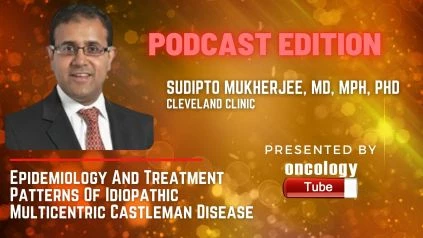Sudipto Mukherjee, MD, MPH, Ph.D., Director of Rare Cancers and Blood Diseases, at the Cleveland Clinic speaks about the Epidemiology and treatment patterns of idiopathic multicentric Castleman disease in the era of IL-6 directed therapy.
Link to Article:
https://doi.org/10.1182/bloodadvances.2021004441
Points to Remember:
* To calculate the incidence and prevalence of iMCD, a novel algorithm based on disease-specific ICD-10-CM codes and diagnostic criteria were developed.
* Despite being the only FDA-approved medication, siltuximab is rarely used in iMCD patients.
The epidemiology of HHV-8-deficient/idiopathic multicentric Castleman disease (iMCD) is still unknown. Due to a lack of uniform diagnostic criteria and a disease-specific International Classification of Diseases (ICD) code, previous epidemiologic studies of CD and iMCD have had difficulty accurately identifying cases. In this study, we use a novel claims-based algorithm to provide reliable estimates of CD and iMCD in the US, which includes a CD-specific ICD-10 diagnosis code (D47.Z2) and the presence of two claims codes corresponding to minor criteria from the international evidence-based diagnostic criteria for iMCD. We also looked at the different types of treatments and how they were used in the clinical course of iMCD patients. We identified 254 iMCD patients using an administrative claims database of 30.7 million people recruited between January 1, 2017, and December 31, 2018, with annual incidence and prevalence estimates of 3.4 (95 percent CI, 1.4 – 9.2) and 6.9 (95 percent CI, 3.7 – 13.3) cases per million, respectively. Patients with iMCD were given corticosteroid monotherapy in 39% of cases, no iMCD-directed medication in 33.1 percent of cases, and IL-6 targeted therapy with tocilizumab or siltuximab in 9.8% of cases. Only 8.7% of iMCD patients received siltuximab, the only FDA-approved medication and established first-line treatment prescription. This research presents the most up-to-date picture of the iMCD disease burden in the United States and shows a significant unmet therapeutic need for IL-6 focused therapy in this susceptible group.

